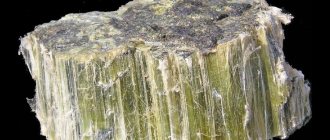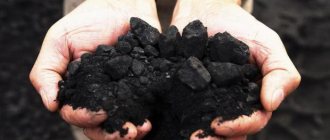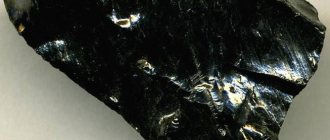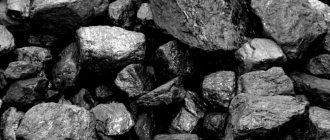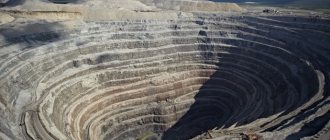Coal is a rock of organic origin, occurring in layers. Intensive mining of this mineral began in the 18th century and reached its peak in the 70s of the last century. Now interest in coal as a fuel resource is growing, and production methods are being improved. When extracting minerals, they begin to pay special attention to the protection and preservation of the environment.
In this article we will tell you in detail where coal is mined and under what conditions. You will learn what coal mines are called and how they differ from each other. We will also describe different coal mining methods and their main features.
What is coal and what does it look like?
Construction of a mine is a very expensive investment, but over time all costs are fully recouped. When coal is mined, other resources also come to the surface.
There is a possibility of mining precious metals and rare earth elements, which can later be sold and receive additional profit.
Oil is practically the most precious resource and the main source of fuel today. However, not a single company or country that mines coal will neglect its extraction in the name of oil, because solid fuel is also of great importance and high value.
Open way
Developments for coal mining in a coal quarry are classified as open-pit coal mining, since they do not require drilling mines and adits to great depths.
This mining method involves blasting and removing overburden (a layer of excess rock above coal deposits) from the mining site. After this, with the help of excavators, water cannons, bulldozers, crushers, draglines and conveyors, the rock is crushed and transferred further.
This method of coal mining is considered less safe than closed (mine) mining. But it also has certain risk factors associated with careless handling of equipment and large vehicles, the possibility of poisoning from exhaust gases and substances accompanying machine activity.
A significant disadvantage of this method is that it causes great harm to the environment due to the removal of a large area of the earth layer and the natural elements accompanying it.
The open-pit method of coal mining is considered one of the most widespread in the world - with its help more than 55% of coal is mined per year, which amounts to 4102.1 million tons.
Formation of coal
Coal in nature is formed by changing surface topography. Tree branches, plants, leaves and other natural remains that have not had time to rot are saturated with moisture from the swamps, which is why they are converted into peat.
Next, seawater reaches the land, and when it leaves, it also leaves a layer of sediment. After the river makes its own adjustments, the ground becomes swamped, again forms or covers the soil. Therefore, the composition of coal is highly dependent on age.
The hard coal is average in age between brown, the youngest, and anthracite, the oldest.
Hydraulic method
It was first used in the Soviet Union in the 30s of the twentieth century. It involves mining coal in deep mines, while transporting coal rock to the surface using energized water jets. This method allowed us to use the disadvantage of underground coal mining - groundwater - for our benefit.
Recently, hydraulic coal mining has been considered one of the most respectable methods.
It can replace the labor-intensive and dangerous process of coal mining by miners, instead of which water will act as a destructive and lifting force.
The disadvantages of this method of coal mining include the following:
- constant contact of working tools and mechanisms with water and rock;
- certain difficulties when replacing or repairing work equipment;
- the dependence of the coal mining process on the thickness, angle of inclination and hardness of the rock.
Approximately 7.5% of coal is produced annually using this method, which amounts to 545.5 million tons.
Types of coal, their composition and properties
There are several types of coal:
- long flame,
- gas,
- fatty,
- coke,
- low-caking,
- skinny.
Also common are species consisting of several, so-called mixed, having the properties of two groups.
Coal is distinguished by its black color, hard, layered, easily destructible structure, and has shiny inclusions. The combustible properties are quite high, since the material is used as fuel.
Let's consider the physical characteristics:
- Density (or specific gravity) varies greatly (the maximum can reach 1500 kg/m³).
- The specific heat capacity is 1300 J/kg*K.
- Combustion temperature 2100°C (during processing 1000°C).
Coal producing countries
The leaders in terms of coal production volumes, according to the Statistical Review of World Energy, in 2022 were:
- China – 3,846 million tons.
- India – 756.4 million tons.
- USA – 639.8 million tons.
- Indonesia – 610.0 million tons.
- Australia - 506.7 million tons.
- Russia – 440 million tons.
- South Africa – 254.3 million tons.
- Germany – 133.9 million tons.
- Kazakhstan – 115.4 million tons.
- Poland – 112.4 million tons.
Author: Yuri Florinskikh All articles by this author
Latest articles by the author: The largest producers of milk and dairy products in the world Diamonds: properties, mining methods and applications
Coal deposits in Russia
About a third of the world's reserves are located on Russian territory.
Coal and oil shale deposits in Russia (click to enlarge)
The largest coal deposit in Russia is Elginskoye. It is located in the Yakutia region.
Reserves, according to approximate calculations, amount to more than 2 billion tons.
Origin
Coal appeared long before the appearance of man. Its approximate age is 200-400 million years. How coal came to be is still unclear.
There are 4 theories according to which coal may have appeared.
- The most common is the formation of peat, and then coal, due to the decay of ferns, mosses, and horsetails. However, this theory cannot explain fossil layers 400–700 meters thick. After all, to form 500 meters of fossils, 2000 meters of peat are required, i.e. plants of the same species had to grow on the territory for millions of years without changes in weather conditions.
- Thermal theory - slow smoldering of plant residues in an environment with a low oxygen content with gradual transformation into ordinary coal, and then into stone. However, plant parts would not be preserved inside the fossils.
- Sea water version. Having fallen into the ocean, the plants underwent a long process of carbonization, being under pressure and without oxygen. The theory is confirmed by marine finds - algae, sand.
- Abiogenic - coal appeared by heating methane in the presence of hydrogen and carbon dioxide. According to this theory, the finds in the layers are not the remains of plants, but pyrolytic graphite, therefore it is impossible to reliably determine the age of the mined minerals.
When extracting minerals, very interesting features are discovered:
- The mineral's flippers reveal upright tree trunks.
- Sometimes during mining, stone deposits of igneous origin weighing up to 75 kilograms are located together with coal.
- Less often, deposits of gold and metal can be found next to coal, which indicates an active coal formation process.
- Carbonaceous environments are often inhabited by annelids or the remains of mollusks.
- Round-shaped objects that are difficult to identify. There is a version that these are dinosaur eggs.
The largest coal deposits in the world
The first country in the ranking in terms of the amount of coal mined annually is the United States, Russia is in second place.
Map of coal deposits in the world (click to enlarge)
In the United States, the most famous coal basin is the Illinois. The total reserves of deposits in this field amount to 365 billion tons.
Next comes the Ruhr Basin, located on the territory of modern Germany. All deposits and basin development sites are under strict protection.
How are coal deposits found and developed?
Places where there is coal on the planet have long been explored. Its reserves in different countries are huge; they will be enough for heating and industrial needs for almost three centuries. But according to geologists, there may be more of them , since deep geological prospecting for the presence of coal fuel was not carried out in all parts of the world. The development of coal deposits is relevant and brings significant income to the states that are engaged in the extraction of this solid black gold. The process of developing deposits is carried out depending on the terrain and the depth of the coal seams.
Interesting: Why do you feel thirsty after eating something salty or sweet? Reasons, photos and videos
Coal mining
In our time, hard coal is mined in three fundamental ways. Such as:
- career method
- mining through adits,
- mining method.
The quarry mining method is used when coal seams lie on the surface, approximately one hundred meters deep or higher.
Quarries involve simply digging up the ground or sand pit from which mining is carried out; usually in such cases the coal seam is quite thick, which makes its extraction easier.
Adits mean wells with a large angle of inclination. All mined minerals are transported upward along it, without the need to use serious equipment or dig out a basin.
Typically, deposits in such places are thin and not buried particularly deep. Therefore, the method of mining through adits allows for rapid production without special costs.
Mining through mines is the most common method of extracting minerals, at the same time the most productive, but at the same time dangerous. The mines are drilled to great depths, reaching several hundred meters. However, this requires a permit confirming the justification for such large-scale work and evidence of the presence of deposits.
Sometimes the mines can reach a kilometer or more in depth, and stretch for several kilometers in length, forming interconnected webs of corridors underground. In the 20th century, settlements and small towns were eventually formed around the mines, in which miners and their families lived.
It is precisely because of the mining conditions that work in the mines is considered very difficult and dangerous, because a huge number of times the mines collapsed, burying dozens or even hundreds of people working there.
Mine method
This method is used when mining coal from great depths and has an undeniable advantage over open-pit coal mining methods: coal at great depths is of higher quality and contains virtually no impurities.
To access coal seams, horizontal or vertical tunnels (adits and shafts) are drilled. There are known cases of coal mining at depths of up to 1500 meters (Gvardeiskaya, Shakhterskaya-Glubokaya mines).
Underground coal mining is considered one of the most difficult specializations due to a number of dangers:
- There is a constant threat of groundwater breaking into the mine shaft.
- There is a constant threat of associated gases breaking into the mine shaft. In addition to possible suffocation, explosions and fires are a particular danger.
- Accidents due to high temperatures at great depths (up to 60 degrees), careless handling of equipment, etc.
Using this method, approximately 36% of the world's coal reserves are extracted from the earth's interior, which amounts to 2625.7 million tons.
Economic significance
Beginning in 1970, the Russian government began to reorient the energy complex towards the use of gas. The Ministry of Energy and Coal Industry was faced with the task of ensuring faster growth rates in the energy sector compared to industry.
The annual increase in coal production since 1999 has not occurred at sufficient speed. Coal accounts for only 18% of the Russian energy balance, although the world average is about 40%. Such a low figure cannot ensure the country's energy security.
Rising prices for oil and gas once again force us to pay attention to the coal resource. In 2007, the Minister of Coal Industry adopted a scheme for the placement of energy facilities until 2020, according to which the share of gas stations will decrease by 30-35%, and those operating on coal will increase to 31-38%. Changes will also affect the fuel balance; the share of gas should decrease from 68% to 50%.
Problems
A serious crisis between 1991 and 1994 led to a halving of production and export volumes. More than half of Russian coal mines (about 60%) have a service life of 20 years, however, despite this, they have never been reconstructed during the entire period of operation. Also during the USSR they were supported by government subsidies. Free market prices and the lack of government support eventually drew a payback line below which several companies found themselves, which led to the closure of a number of mines due to their unprofitability.
Adaptation to new market conditions was completed by 2010, during which the situation improved significantly: production volume had already reached 320 million tons, and investment growth had also resumed.
Development and maintenance of existing coal basins requires labor, but there is a significant shortage in this area. This state of affairs is associated with low wages and difficult working conditions. Also, many development sites are located in hard-to-reach regions and harsh climatic conditions. The combined influence of these factors, coupled with low wages, creates a labor shortage.
Development prospects
Coal is an important resource for Russia, a scientific and high-tech approach to its processing can become a reliable source of budget funds.
There are several prospects for the development of the coal industry:
- Coal chemistry.
- Coke chemistry - production of metallurgical coke and related elements.
- Production of nanomaterials.
- Development of environmentally friendly methods of burning coal.
- Production of building materials from recycled coal industry waste.
- Degassing of coal seams.
A general increase in the profitability of the coal industry can be achieved by large-scale degassing of coal seams.
C + H2O —> H2 + CO
This gas can be used as fuel in power plants and also as a feedstock for the Fischer-Tropsch . In 1925, the director of the German Kaiser Wilhelm Institute for Coal Research, Franz Fischer , and his colleague Hans Tropsch obtained liquid motor fuel from synthesis gas. Carbon monoxide is reduced by hydrogen at normal pressure and a temperature of about 270 °C in the presence of specific catalysts. The result is a liquid mixture of hydrocarbons, which, after purification, can be used as motor fuel. During World War II, Germany, poor in oil but rich in coal, synthesized fuel for military vehicles in this way.
Classification of coal by grade
As already mentioned, coal may differ in composition. It is extremely difficult to isolate specific compounds in the composition of coal, therefore, in order to characterize coal, only a few characteristics are used: concentration of volatile substances, humidity, carbon content, calorific value, etc.
Usually all these characteristics are connected. The higher the carbon content of coal and the lower the volatile content, the more heat the fuel can produce. According to these characteristics, coal is divided into grades.
Volume of emissions of harm to the environment
In addition to the impact on human health, the use of coal poses serious consequences for the environment and for ecology in general. Disappearance of streams, alteration of natural drainages, water pollution, additional erosion, and acidic runoff into surface waters are just some of the potential impacts.
The Surface Mining Control and Reclamation Act is being enacted around the world, requiring strips of mined land to be returned to their original biotic productivity.
Like all fossil fuels, coal emits carbon dioxide when it is burned. In fact, fossils are responsible for most of the carbon dioxide emissions. Additionally, most of this mineral also contains certain amounts of other elements such as sulfur, mercury, and sometimes lithium. Combustion results in the formation of NOx and SOx.
Brown coal (B)
This is the youngest and therefore least useful grade of coal. It looks like a brown stone mass. Sometimes the woody structure is even noticeable on it. The heat output is only 22 MJ/kg. The reason for this is the low carbon content, large amounts of moisture, volatile substances and mineral impurities. All this does not ensure efficient combustion.
Such coal is formed directly from peat and lies at a shallow depth (from 10 to 200 meters). In Russia, it is mined at the Solton deposit, in the Tunguska and Kansko-Achinsk coal basins.
Other types of classifications
In addition to the brands presented above, there are many intermediate brands, for example, fatty coke (KZh), gas sintering (GS), long-flame gas (LDG).
Also, each grade of coal may have different pieces sizes. In this case, the letter indicating the variety is located after the letter indicating the brand. For example, anthracite-nut (AO), fat-slab (ZhP), coke seed (KS).
There is also a classification of coal by origin. All coal, as already mentioned, is formed from plants over millions of years. But plants can have different natures. Thus, coals are divided into humus (from wood, leaves, stems) and sapropelite (from the remains of lower plants, such as algae).
